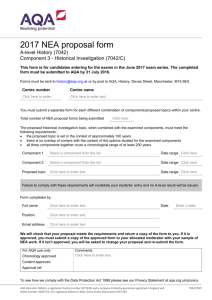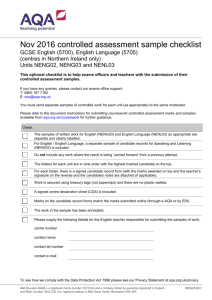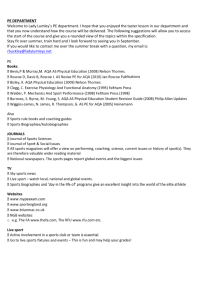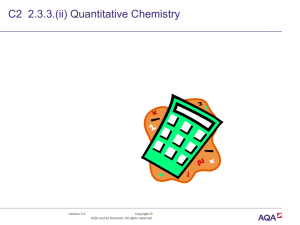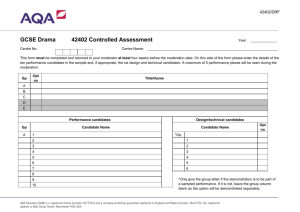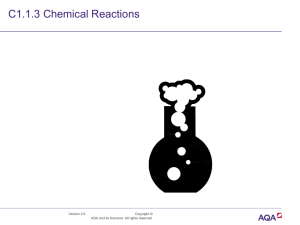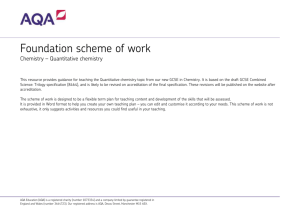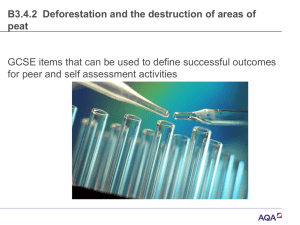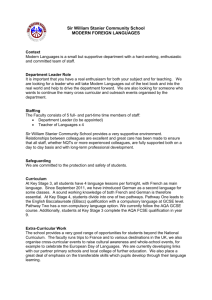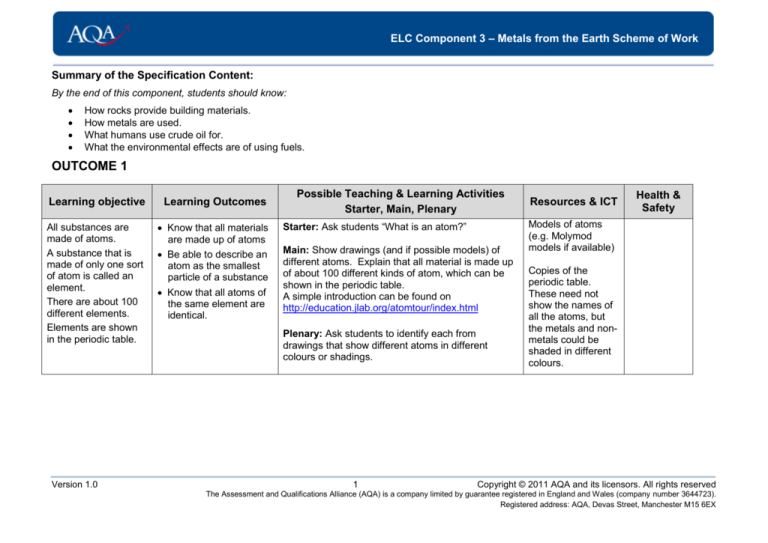
ELC Component 3 – Metals from the Earth Scheme of Work
Summary of the Specification Content:
By the end of this component, students should know:
How rocks provide building materials.
How metals are used.
What humans use crude oil for.
What the environmental effects are of using fuels.
OUTCOME 1
Learning objective
Learning Outcomes
All substances are
made of atoms.
A substance that is
made of only one sort
of atom is called an
element.
There are about 100
different elements.
Elements are shown
in the periodic table.
Know that all materials
are made up of atoms
Be able to describe an
atom as the smallest
particle of a substance
Know that all atoms of
the same element are
identical.
Version 1.0
Possible Teaching & Learning Activities
Starter, Main, Plenary
Starter: Ask students “What is an atom?”
Main: Show drawings (and if possible models) of
different atoms. Explain that all material is made up
of about 100 different kinds of atom, which can be
shown in the periodic table.
A simple introduction can be found on
http://education.jlab.org/atomtour/index.html
Plenary: Ask students to identify each from
drawings that show different atoms in different
colours or shadings.
1
Resources & ICT
Health &
Safety
Models of atoms
(e.g. Molymod
models if available)
Copies of the
periodic table.
These need not
show the names of
all the atoms, but
the metals and nonmetals could be
shaded in different
colours.
Copyright © 2011 AQA and its licensors. All rights reserved
The Assessment and Qualifications Alliance (AQA) is a company limited by guarantee registered in England and Wales (company number 3644723).
Registered address: AQA, Devas Street, Manchester M15 6EX
ELC Component 3 – Metals from the Earth Scheme of Work
OUTCOME 2
Learning objective
Learning Outcomes
When elements react,
their atoms join with
other atoms to form
compounds.
Explain that when
atoms of different
elements combine they
form compounds
Chemical reactions
can be represented by
word equations.
Be able to write a
simple word equation
Possible Teaching & Learning
Activities
Starter, Main, Plenary
Resources & ICT
Starter: Ask “What do we call a material
that is made up of several kinds of atom?”
Show some simple diagrams of a material
made up of two kinds of atom – joined
together (compound) and not joined
(mixture) of
A good web site showing
differences between
elements, mixtures and
compounds in a simple way is
http://www.chem.purdue.edu/
gchelp/atoms/elements.html
Health &
Safety
Main:
Distinguish between elements, mixtures
and compounds.
Explain that a chemical reaction occurs
when atoms of different substances join
together in different ways
Give examples of simple chemical
reactions in word equations, e.g.
Calcium + oxygen calcium oxide
Plenary: Worksheet with 2 or 3 word
equations on which they need to complete.
Version 1.0
2
Copyright © 2011 AQA and its licensors. All rights reserved
The Assessment and Qualifications Alliance (AQA) is a company limited by guarantee registered in England and Wales (company number 3644723).
Registered address: AQA, Devas Street, Manchester M15 6EX
ELC Component 3 – Metals from the Earth Scheme of Work
OUTCOME 3
Learning objective
Learning Outcomes
Limestone, mainly
composed of the
compound calcium
carbonate, is quarried
and can be used as a
building material.
Correctly identify
calcium carbonate as a
constituent of limestone.
Know that limestone has
to be dug from the
ground in quarries, and
know some of the social,
economic and
environmental effects of
quarrying.
Understand why
limestone is an
important building
material and suggest
some of its uses.
Describe how cement is
made from limestone
and how cement can be
used to make mortar
and concrete
Limestone is heated
with clay to make
cement. Cement is
mixed with sand to
make mortar and with
sand and aggregate to
make concrete.
Version 1.0
Possible Teaching & Learning
Activities
Starter, Main, Plenary
Starter: How is limestone quarried?
Main: Discuss making mortar, cement &
concrete using limestone as starting
material
Plenary: List as many uses of limestone
as you can think of.
3
Resources & ICT
Website “What is cement and
how is it made?
http://www.buildeazy.com/new
plans/eazylist/cement.html
Also a YouTube video
http://www.youtube.com/watch
?v=n-Pr1KTVSXo
Health &
Safety
If working
with
cement,
remember
to wear
gloves and
goggles
because of
the caustic
nature of
cement.
Copyright © 2011 AQA and its licensors. All rights reserved
The Assessment and Qualifications Alliance (AQA) is a company limited by guarantee registered in England and Wales (company number 3644723).
Registered address: AQA, Devas Street, Manchester M15 6EX
ELC Component 3 – Metals from the Earth Scheme of Work
OUTCOME 4
Learning
objective
Ores contain enough
metal to make it
economical to extract
the metal.
Unreactive metals,
such as gold, are
found in the Earth as
the metal itself, but
most metals are
found as compounds
that require chemical
reactions to extract
the metal.
We should recycle
metals to save
resources.
Version 1.0
Learning Outcomes
Explain the meaning of
the term “ore”
Name an unreactive
metal that can be found
as the metal itself in
the Earth.
Suggest why most
metals are found as
compounds in the
Earth.
Explain why scrap
metal should be
recycled.
Possible Teaching & Learning Activities
Starter, Main, Plenary
Starter: What is an ore?
Main: Discuss the metal ores in earth and the
method of extraction.
Discuss environmental impact and benefits of
recycling metals.
Plenary: Make a list of metals that can be
recycled.
4
Resources & ICT
Health
&
Safety
The website
http://www.gcsescience.com/ex1.
htm
contains some useful
information, although some of it
may be too advanced.
Enter “metal ores” into Google
and you can look at some nice
colour pictures of different ores.
Copyright © 2011 AQA and its licensors. All rights reserved
The Assessment and Qualifications Alliance (AQA) is a company limited by guarantee registered in England and Wales (company number 3644723).
Registered address: AQA, Devas Street, Manchester M15 6EX
ELC Component 3 – Metals from the Earth Scheme of Work
OUTCOME 5
Learning
objective
Most iron is
converted into
steels.
Steels are
alloys since
they are
mixtures of iron
with carbon
and other
metals.
Version 1.0
Possible Teaching & Learning Activities
Starter, Main, Plenary
Learning
Outcomes
Know why most
iron is converted
into steel.
Understand the
meaning of the
term “alloy”
Resources & ICT
Starter: What is an alloy?
Main: Discuss the differences between iron and steel.
Why is most iron made into steel? What are the physical
properties of iron and steel?
Health &
Safety
Corus has produced a useful
website.
http://resources.schoolscience.co.
uk/corus/1416/steel/msch1pg4.html
Pages 5, 6 and 8 are the most
useful.
Plenary: List all the things in the classroom that contain
steel.
5
Copyright © 2011 AQA and its licensors. All rights reserved
The Assessment and Qualifications Alliance (AQA) is a company limited by guarantee registered in England and Wales (company number 3644723).
Registered address: AQA, Devas Street, Manchester M15 6EX
ELC Component 3 – Metals from the Earth Scheme of Work
OUTCOME 6
Learning
objective
Most metals in
everyday use
are alloys.
Pure iron,
copper, gold
and aluminum
are too soft for
many uses and
so are mixed
with small
amounts of
other elements
to make them
harder for
everyday use.
Version 1.0
Possible Teaching & Learning Activities
Starter, Main, Plenary
Learning
Outcomes
Name some
examples of alloys
Explain why iron,
copper, gold and
aluminium are
usually made into
alloys.
Starter: Can you name some common alloys?
Main: List some common alloys, e.g. brass, bronze and pewter,
and discuss their characteristics/ uses
Resources & ICT
Health &
Safety
For a list of the constituents
of common alloys, see
http://www.machineryfaq.co
m/metal-forming/metalforming-146.html
Plenary: Discuss why “silver” and “copper” coins are made of
allows rather than the pure metal
6
Copyright © 2011 AQA and its licensors. All rights reserved
The Assessment and Qualifications Alliance (AQA) is a company limited by guarantee registered in England and Wales (company number 3644723).
Registered address: AQA, Devas Street, Manchester M15 6EX
ELC Component 3 – Metals from the Earth Scheme of Work
OUTCOME 7
Possible Teaching & Learning Activities
Starter, Main, Plenary
Learning
objective
Learning
Outcomes
Copper has
properties that
make it useful
for electrical
wiring and
plumbing.
Low density
and resistance
to corrosion
make
aluminum a
useful metal.
Know that copper is
a good conductor of
heat and electricity.
Give reasons why
aluminium is a
useful metal.
Version 1.0
Resources & ICT
Health &
Safety
Top pan balance
Blocks of different materials.
Starter: Why is copper used for wiring?
Main: Show some artefacts made from copper and aluminium.
Introduce the idea of density as how heavy something is for its
size.
Try weighing identically sized blocks of copper, aluminium, lead
and steel.
Plenary: Half the class write down as many uses as they can
think of for copper; the other half lists uses of aluminium. Which
half has the most uses?
7
Copyright © 2011 AQA and its licensors. All rights reserved
The Assessment and Qualifications Alliance (AQA) is a company limited by guarantee registered in England and Wales (company number 3644723).
Registered address: AQA, Devas Street, Manchester M15 6EX
ELC Component 3 – Metals from the Earth Scheme of Work
OUTCOME 8
Learning
objective
Crude oil is a
mixture of a very
large number of
compounds, and
may be found in
deposits
underground, eg the
oil fields under the
North Sea.
Crude oil may be
separated into
fractions by
distillation.
This process, which
takes place in a
refinery, can be
used to produce a
range of useful fuels
and oils.
Version 1.0
Learning Outcomes
Describe what sort of
substance crude oil is,
and where it can be
found.
Know that before it is
used, crude oil is
separated into
different fractions by
heating it.
State that the
distillation of crude oil
takes place in a
refinery.
Name some of the
useful products that
can be obtained from
crude oil.
Possible Teaching & Learning Activities
Starter, Main, Plenary
Starter: What is crude oil, and what does it mean to
say that it is crude?
Main: How is it obtained? How do we obtain useful
products from the fractions
Plenary: How many everyday products can you
think of that are made from crude oil?
Resources & ICT
Health &
Safety
A good web site to start with
about crude oil is
http://resources.schoolscience.co.
uk/SPE/knowl/4/2index.htm?crud
e.html
For fractional distillation try
http://science.howstuffworks.com/
environmental/energy/oilrefining4.htm
There is also a video on
http://www.youtube.com/watch?v
=vscX_zawdQw
8
Copyright © 2011 AQA and its licensors. All rights reserved
The Assessment and Qualifications Alliance (AQA) is a company limited by guarantee registered in England and Wales (company number 3644723).
Registered address: AQA, Devas Street, Manchester M15 6EX
ELC Component 3 – Metals from the Earth Scheme of Work
OUTCOME 9
Learning objective
Learning Outcomes
Most fuels, including
coal, contain carbon
and/or hydrogen and
may also contain
some sulfur. When
they burn energy is
released.
The gases released
into the atmosphere
when a fuel burns
completely include
carbon dioxide, water
(vapour), and sulfur
dioxide if the fuel
contains sulfur.
Carbon dioxide
causes global
warming and sulfur
dioxide causes acid
rain.
.
Recall the names of
some fuels.
State that most fuels
contain carbon
and/or hydrogen.
Understand that
when fuels are
burned they release
energy.
State that when a
fuel containing
carbon is burned,
carbon dioxide and
water vapour are
released.
Know that some fuels
contain sulfur which
produces sulfur
dioxide when burned.
Know that carbon
dioxide produces
global warming and
sulfur dioxide
produces acid rain.
Version 1.0
Possible Teaching & Learning Activities
Starter, Main, Plenary
Starter: Discuss what happens when a fuel
burns.
Main: Investigate the products of combustion:
Light a Bunsen or a candle under a
beaker of very cold water. The outside
of the beaker “mists up”. This is
because water vapour produced by the
burning fuel has condensed on the
outside of the beaker.
Look at the underside of the beaker
(especially if the Bunsen is on a yellow
flame) Why is it black? Because of the
soot (carbon) produced.
If possible, draw some of the gases
produced through lime water to show
that carbon dioxide is produced
Plenary: List the consequences of (a) global
warming or (b) acid rain.
9
Resources & ICT
A good website for the products of
combustion is the Royal Society of
Chemistry
http://www.practicalchemistry.org/ex
periments/identifying-the-productsof-combustion,43,EX.html
Health &
Safety
Take care
when burning
candles
One way of demonstrating acid rain
is:
Take a big ball of cotton wool(to
represent a cloud)
Spray it with a fine mist of water.
Put the cotton wool in a large
upturned beaker and burn
matches underneath it. (These
give off some sulfur dioxide).
Alternatively you could dissolve
some Camden tablets in the
water you used for spraying.
(These are used by home
winemakers to sterilise
equipment. They release sulfur
dioxide when they dissolve)
Squeeze the “cloud” over a
beaker of water to which you
have added some Universal
Indicator solution. The water will
turn red indicating the acidity.
Copyright © 2011 AQA and its licensors. All rights reserved
The Assessment and Qualifications Alliance (AQA) is a company limited by guarantee registered in England and Wales (company number 3644723).
Registered address: AQA, Devas Street, Manchester M15 6EX
ELC Component 3 – Metals from the Earth Scheme of Work
OUTCOME 10
Possible Teaching & Learning Activities
Starter, Main, Plenary
Learning
objective
Learning
Outcomes
When fuels
burn in a
limited supply
of air a
poisonous,
odourless gas
called carbon
monoxide is
produced.
Solid particles
(soot) may also
be produced.
Know that without
adequate
ventilation, carbon
monoxide and soot
may be produced
when a fuel is
burned.
.Know that carbon
monoxide is a
poisonous gas.
Starter: Show a newspaper article about an accident involving
carbon monoxide poisoning caused by poor ventilation.
Smoke detectors and
carbon monoxide
detectors to show
students.
Main: Discuss the dangers of poor ventilation. If possible show
two types of carbon monoxide detector (electronic and card) and
talk about the desirability of using them.
Useful websites are:
http://www.bbc.co.uk/heal
th/physical_health/conditi
ons/carbonmonoxide1.sht
ml
Discuss how suffocation could be caused even without carbon
monoxide because of carbon dioxide produced.
Discuss the use of smoke detectors.
Plenary: Where in the house should you fit a smoke detector?
Version 1.0
Resources & ICT
10
Health &
Safety
or
http://www.nhs.uk/conditi
ons/carbon-monoxidepoisoning/Pages/Introduc
tion.aspx
Copyright © 2011 AQA and its licensors. All rights reserved
The Assessment and Qualifications Alliance (AQA) is a company limited by guarantee registered in England and Wales (company number 3644723).
Registered address: AQA, Devas Street, Manchester M15 6EX

